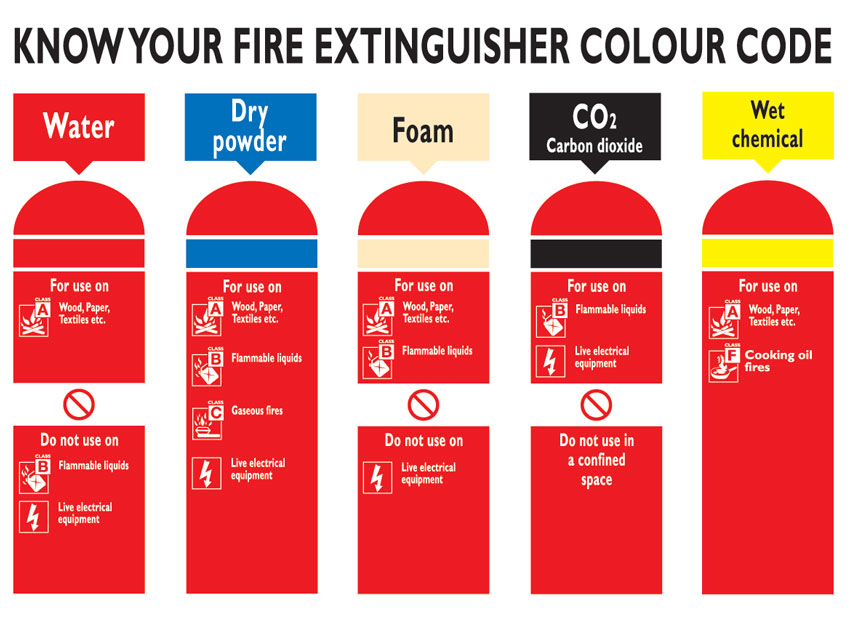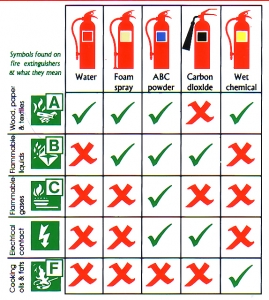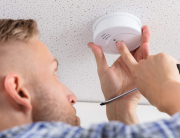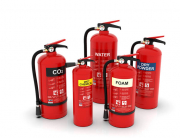Whilst operating a fire extinguisher is a relatively simple procedure, knowing how to use one properly in the event of a fire can help you deal with the situation safely and calmly.
When it comes to knowing how to use a fire extinguisher, one of the most important things to understand is that there are several types designed to put out different kinds of fire.
Most fires are sorted into the following classifications in the UK:
CLASS A:
Ordinary combustible fires involving materials such as wood, paper, textiles, rubber and some plastics.
CLASS B:
These fires involve flammable liquids that have an ignition temperature of less than 100°C. Examples include petrol, kerosene, alcohol, solvents and paint.
CLASS C:
Gases such as butane, propane and petroleum are all flammable and have the potential to create an explosion.
CLASS D:
Some metals and powdered metals can burn if ignited although it does take a lot of heat to do so.
ELECTRICAL:
Electrical fires can be started by a short circuit, overloaded switchboards, faulty equipment and damaged wires.
CLASS F (or CLASS K):
These types of fires involve cooking oil and fats and can be particularly difficult to tackle due to the high temperatures and the rapid spreading of flames.
Once you understand what kind of fire you are dealing with – you can choose the appropriate fire extinguisher to use.
How to use a Water Extinguisher
Identifiable by a red label, water extinguishers should only be used on Class A fires and never on Class F or electrical fires.
- Check the extinguisher is fully charged – the pressure gauge on the neck should be in the green area and the safety pin intact and not bent
- Be certain there is no live electrical equipment or wires in the area
- From a safe distance (around 8ft) remove the safety pin breaking the tamper seal and freeing the lever on top of the extinguisher
- Aim the nozzle or hose at the base of the fire and squeeze the lever gently to start discharging the extinguisher
- Move the jet across for flames spreading horizontally or up in the direction of the fire for flames spreading vertically moving closer as the fire starts to diminish
- Continue until the fire is extinguished paying particular attention to any hot spots that may re-ignite
How to use a Foam Extinguisher
Identified by a cream label, these types of extinguisher should only be used on Class A and B and electrical fires if the extinguisher has been tested to 35kV (dielectric test) but never on a chip pan or fat fire. Operation of a foam extinguisher differs depending on which type of fire it is being used for.
- Check the extinguisher is fully charged – the pressure gauge on the neck should be in the green area and the safety pin intact and not bent
- From a safe distance remove the safety pin breaking the tamper seal and freeing the lever on top of the extinguisher
- When aiming the nozzle or hose at the fire:
- Electrical fires – keep a distance of at least 1m
- Class A fires – aim at the base of the fire, working across the area of flames
- Class B fires – Do not spray directly onto the fire as this could cause the flames to spread. Instead aim at a nearby vertical surface allowing the foam to build up and smother the flames
- Squeeze the lever gently to start discharging the extinguisher
- Ensure the fire is fully extinguished – the foam will act as a blanket smothering the flames and preventing the fire from re-igniting
How to use a CO2 Extinguisher
Identified by a black label, carbon dioxide extinguishers are for use on Class B and electrical fires. Special care should be taken in small and confined spaces as the gas can asphyxiate and once dissipated there is the potential for fires to re-ignite. They should never be used on chip pan or fat fires.
- Check the safety pin is intact and not bent
- From a safe distance (around 8ft) remove the safety pin breaking the tamper seal and freeing the lever on top of the extinguisher
- Only hold the horn on the hose if it is a frost-free horn, the horn will become extremely cold and could cause frost burns
- When aiming the nozzle or hose at the fire:
- Class B fires – Aim the horn at the base of the fire and move across the area of flames
- Electrical fires – If safe and possible, switch off the power and direct the horn straight at the fire
- Squeeze the lever gently to start discharging the extinguisher
- Ensure the fire is fully extinguished – taking extra care as fires can re-ignite once the CO2 has dissipated
How to use a Powder Extinguisher
Identified by a blue label, powder extinguishers can be used on Class A, B and C fires but not chip pan or fat fires. Operation of a powder extinguisher differs depending on which type of fire it is being used for.
- Check the extinguisher is fully charged – the pressure gauge on the neck should be in the green area and the safety pin intact and not bent
- From a safe distance remove the safety pin breaking the tamper seal and freeing the lever on top of the extinguisher
- When aiming the nozzle or hose at the fire:
- Class A fires – aim at the base of the fire working across the area of flames
- Class B fires: spilled liquids – aim the hose at the near edge of the fire and with rapid sweeping movements force the flames to the far edge until all the flames have been extinguished
- Class B fires: flowing liquids – aim the hose at the base of the flames and in a sweeping movement work upwards until all the flames have been extinguished
- Electrical fires – If safe and possible, switch off the power and direct the hose straight at the fire
- Squeeze the lever gently to start discharging the extinguisher
- Ensure the fire is fully extinguished – the foam will act as a blanket smothering the flames and preventing the fire from re-igniting
How to use a Wet Chemical Extinguisher
Identified by a canary yellow label, wet chemical extinguishers are ideal for Class A, B and F fires.
- Check the extinguisher is fully charged – the pressure gauge on the neck should be in the green area and the safety pin intact and not bent
- If safe to do so, switch off the power or heat source
- From a safe distance (at least 1m) remove the safety pin breaking the tamper seal and freeing the lever on top of the extinguisher
- Holding the lance at arm’s length, aim the nozzle well above the fire and squeeze the lever gently to start discharging the extinguisher
- Apply the spray in a circular motion, allowing a mist to fall onto the flames and prevent any oil or liquid splashing
- Continue until the entire contents of the extinguisher is used and the fire is out
At Northants Fire, we’re all about ensuring your home and business is safe and understands best how to deal with fire as and when they may occur, but preventative methods are always best so do check out some of our other blogs posts outlining some of these measures. We do fire risk assessments so that you can flag up any issues and tackle problems before they cause a fire.
We hope this guide to using the various types of fire extinguishers has been useful, and do share it with your workforce and loved ones!







